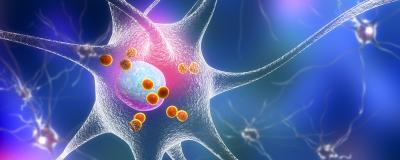Please note: There are additional researchers from other institutions involved in each of the listed studies. We highlighted the providers at Rush to feature their current work with DBS.
Subthalamic nucleus deep brain stimulation with a multiple independent constant current-controlled device in Parkinson's disease (INTREPID): A multicentre, double-blind, randomized, sham-controlled study
Sepehr Sani, MD, Jessica A. Karl, PhD, PA-C, Leonard Verhagen, MD, PhD, et al.
Background: The goal was to assess subthalamic nucleus DBS, with a novel multiple independent contact current-controlled (MICC) device, in patients with Parkinson's disease.
Conclusion: This double-blind, sham-controlled, randomized controlled trial provides class I evidence of the safety and clinical efficacy of subthalamic nucleus DBS with a novel MICC device for the treatment of motor symptoms of Parkinson's disease. Future trials are needed to investigate potential benefits of producing a more defined current field using MICC technology, and its effect on clinical outcomes.
A Novel DBS Paradigm for Axial Features in Parkinson's Disease: A Randomized Crossover Study
Jessica A. Karl, PhD, PA-C, Leonard Verhagen, MD, PhD, et. al
Background: High-frequency (HFS) DBS of the subthalamic nucleus is more effective for appendicular than axial symptoms in Parkinson's disease. Low-frequency stimulation (LFS) may reduce gait/balance impairment, but typically results in worsening appendicular symptoms.
We created a "dual-frequency" programming paradigm (interleave-interlink, IL-IL) to address both axial and appendicular symptoms. In IL-IL, 2 overlapping LFS programs are applied to the DBS lead, with the overlapping area focused on the optimal cathode. The non-overlapping area (LFS) is thought to reduce gait/balance impairment, whereas the overlapping area (HFS) aims to control appendicular symptoms.
Conclusion: Our results prompt consideration of this novel programming paradigm (IL-IL) for PD patients with axial symptom impairment as a new treatment option for both axial and appendicular symptoms.
Reliability and Stability of Programming Directional Deep Brain Stimulation (In process)
Jessica A. Karl, PhD, PA-C, Chandler Gill, MD, MS, Leonard Verhagen, MD, PhD, et al.
Objective: To determine the reliability and stability of programming directional deep brain stimulation (d-DBS) systems.
Background: Conventional omni-directional deep brain stimulation (o-DBS) of the subthalamic nucleus is a proven therapy used to reduce symptoms of advanced Parkinson’s disease. The efficacy of o-DBS can be limited by side effects such as dysarthria, tonic muscle contraction, and gait imbalance because of current spread to adjacent structures. Recently, d-DBS systems have emerged to overcome some of the limitations associated with o-DBS.
D-DBS leads have the same four cylindrical electrode levels as in o-DBS systems, but the middle two electrodes are split into three individual segments that can be independently activated. This allows for “steering” of electrical current towards the intended target and away from neighboring structures offering improved clinical efficacy. The higher number of electrodes in d-DBS systems has led to a 1680-fold increase in electrode permutations, increasing programming complexity. To the best of our knowledge, the stability and reliability of d-DBS electrode segment selection has not been determined. This is important because d-DBS will only be valuable if clinicians can reliably identify optimal stimulation parameters clinically.
The Medial Subthalamic Nucleus Border as a New Anatomical Reference in Stereotactic Neurosurgery for Parkinson's Disease
Leonard Verhagen, MD, PhD, Sepehr Sani, MD, et al.
Background: The intersection of Bejjani's line with the well-delineated medial subthalamic nucleus (STN) border on MRI has recently been proposed as an individualized reference in subthalamic DBS surgery for Parkinson's disease (PD). We aimed to investigate the applicability across centers of the medial STN border as a patient-specific reference point in STN DBS for PD and explore anatomical variability between left and right mesencephalic area within patients. Furthermore, we aim to evaluate a recently defined theoretic stimulation "hotspot" in a different center.
Results: The medial STN border is applicable across centers as a reference point for STN DBS surgery for PD and seems suitable in order to account for interindividual and intraindividual anatomical variability if one is aware of the discrepancies between T2-weighted imaging and SWI.
Kinesthetic Cells within the Subthalamic Nucleus and Deep Brain Stimulation for Parkinson Disease
Leonard Verhagen, MD, PhD, Sepehr Sani, MD, et. al
Background: We sought to determine the location of kinesthetic cell clusters within the subthalamic nucleus (STN) on magnetic resonance imaging, adjusted for interindividual anatomic variability by employing the medial STN border as a reference point.
Results: By using the medial STN border as a patient-specific anatomic reference point in STN deep brain stimulation for Parkinson disease, we accounted for interindividual anatomic variability and provided accurate insight in the clustering of kinesthetic cells within the dorsolateral STN.
Current Directions in Deep Brain Stimulation for Parkinson's Disease-Directing Current to Maximize Clinical Benefit
Leonard Verhagen, MD, PhD, et al.
Background: Several single-center studies and one large multicenter clinical trial demonstrated that directional deep brain stimulation (DBS) could optimize the volume of tissue activated (VTA) based on the individual placement of the lead in relation to the target.
Results: Overall, an increasing amount of data supports the use of directional DBS. At a minimum, stimulation through directional electrodes can be considered as another tool to improve the benefit/side effect ratio. At a maximum, directionality may become the preferred way to program because of its larger TW and lower energy consumption.
A Case Report of Myoclonus-Dystonia with Isolated Myoclonus Phenotype and Novel Mutation Successfully Treated with Deep Brain Stimulation
Leonard Verhagen, MD, PhD, et al.
Background: DBS has shown significant promise in treating patients with myoclonus-dystonia. Mutations in the epsilon-sarcoglycan gene (SGCE) represent the main known genetic cause. There is only one report in the literature of a patient with positive SGCE mutation and isolated myoclonus phenotype who has been successfully treated with DBS.
Results: Our case confirms the poor response to oral medications and supports the use of GPi DBS for patients with genetically confirmed myoclonus-dystonia and isolated-myoclonus phenotype. In addition, our case represents familial myoclonus-dystonia due to a novel SGCE mutation.
